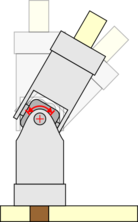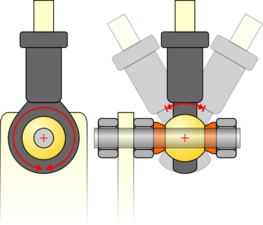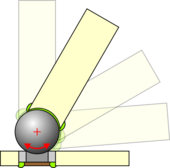Joints for Delta Printer
Contents
Principle and Requirements
TBD
Math / Inverse Kinematic
The predicted nozzle position is given by the software (slicer, G-code) in Cartesian coordinates (X, Y, Z). The firmware has to calculate the position of the 3 vertical carriages so that the nozzle moves to the predicted position. The calculation can be done with 3 “theorem of Pythagoras” (in space).
Math example (simplified)
- DiffX[n] = PredNozzleX - TowerX[n]
- DiffY[n] = PredNozzleY - TowerY[n]
- VertCarriage[n] = Sqrt ( RodLength² - (DiffX[n]² + DiffY[n]² ) ) + PredNozzleZ + ZeroOffsetZ[n]
Error Analysis
The precision of nozzle positioning depends on rod length and a correct nodal point.
In contrast to a cartesian printer the error on a delta printer dependent on the nozzle X/Y position and movement direction. This can result in a curved space and bent printed surfaces.
E.g. a backlash of 0.1 mm in joints can misalign the nozzle up to 1 mm (PositioningError = 2 x Backlash * RodLength / JointDistance)
Other (angle) errors are multiplied by the length of the nozzle (below joints nodal plane).
In result the precision of the printer depends very much on joint precision!
TBD
Joint Variations
Cardan Joint
DIY / RepRap Cardan Joint
Most RepRap delta design uses also printed Cardan joints. Based on this technique the horizontal drills leaks often on precision. Little variation in joints results in much higher nozzle positioning error.
PROs:
- Very low cost
- Can be printed
- Rotational stiffness add stability on effector
CONs:
- Precision depends on manufacturing and assembling. Little manufacturing and assembling error results in a much higher nozzle positioning error
- Design is prone to backlash and misaligned nodal points for vertical and horizontal axis
- Needs more space in construction
USED BY:
Industrial Cardan Joint
There are industrial cardan joints for R/C cars available. Some of them has also plugin adapters with M4 or M5 threads.
TBD
Main Problem: In only 4 directions the joint can be tilt up to 90°. In directions between the usable angle is limited to about 30° (depends on design).
PROs:
- Ready to use
- Less friction
- M4 or M5 mounting threads
- Threaded rods can be used in between
CONs:
- Cost per joint about 12 Euro
- Have to be constructed in e.g. 45° angle to minimize limits
- Have to be mounted in optimal working direction
CHECK:
- Check other manufacturers for wider tilt angle
Rod End Bearing
TBD
Main Problem: At rotation axis the joint is designed for endless rotation. But at the tilt axis the joint is limited by construction. As manufacturer documentation tilt is limited to ±30° (Source: igus.com). To use the maximum (theoretical) reaching area as printing area a tilt angle of 35…40° is necessary. In result you can use only a limited printing area.
PROs:
- Ready to use components
- Threaded rods can be used in between
CONs:
- Limited printing area
- Conical spacer required
CHECK:
- Check other manufacturers for wider tilt angle
USED BY:
Ball-and-Socket Joint
Other variation of the ‘Rod End Bearing’ but with a more limited pivot angle of 25° (Source: igus.com).
Magnetic Joint
- main article: magnet joint
TBD
PROs:
- Precision by design
- No backlash
- Implicit correct and well known nodal point
- Low cost. About 1 Euro per joint
- Simple construction
- Easy assembly
- Easy disconnecting for service and transport
CONs:
- Limited holding force
- In most designs parts have to be glued
- Magnets are sensitive to shock and high temperatures (>80°C)
Magnet Variations
Magnet in Tube
A cylindrical magnet is glued and/or pressed in a tube. The magnet should not touch the steel ball but should also be as near as possible to the ball to get maximum force. The edge of the tube is sliding over the steel ball.
The ‘tube’ can also be drill in the construction.
PROs (additional):
- -
CONs (additional):
- Precision depends on tube cutting, drilling and deflashing
Moving Ring Magnet
The steel balls are mounted (glued) to the lift and effector. The ring magnets are part of the diagonal rods.
PROs (additional):
- -
CONs (additional):
- -
CHECK:
- Long time abrasion of magnets is unknown
Fixed Ring Magnet
The ring magnets are glued and/or pressed in to the lift and effector. The steel balls are part of the diagonal rods.
PROs (additional):
- Depending on design up to (and over) ±90° tilt angle
CONs (additional):
- -
CHECK:
- Long time abrasion of magnets is unknown
USED BY:
Ball Variations
Note: Stainless steel (V2A) balls are not magnetic and can not be used!
Ball from Ball-and-Socket Joint (DIN 71802)
TBD
PROs (additional):
- Screw end
CONs (additional):
- Flat top - limited tilt angle
Bearing Ball
Bearing balls are produced with a very high precision. Even if you get class B merchandise the precision much higher than you need for the delta joints.
Note: Look for “slingshot balls” on eBay.
PROs (additional):
- Low cost (100 pieces for about 10 Euro)
- Implicit high precision
- Very smooth surface – less friction, no abrasion
- Available in all sizes
CONs (additional):
- Have to be glued
USED BY:
Ball from Photo Tripod Ball Head
TBD
PROs (additional):
- Screw end
- Big balls with big magnets for high force
CONs (additional):
- Expensive
CHECK:
- Is ball material magnetic? (Could be chromed brass)
Other Joints
TBD (Feel free to add other variations)





